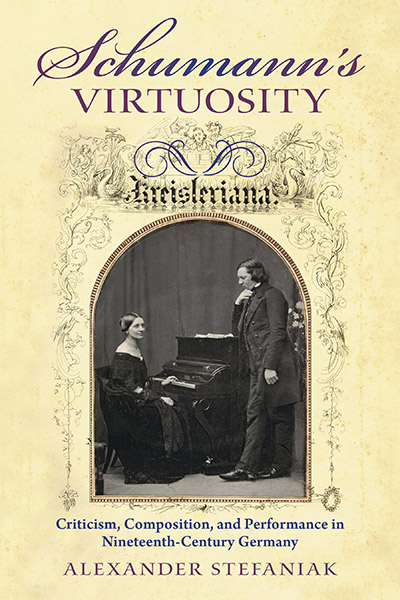https://music.wustl.edu/xml/faculty_staff/11719/rss.xml
Professor Stefaniak’s research focuses on piano culture and performance during the nineteenth century. He teaches courses on topics ranging from eighteenth-century opera to the twentieth-century culture of “classical music."
Alexander Stefaniak explores how virtuoso pianists embodied, shaped, and capitalized upon the ideals and aspirations of nineteenth-century musical culture. His work integrates methodologies that range from archival research to music analysis, and topics that include performance practices, concert programming, gender, canon formation, and musical aesthetics. Stefaniak is the author of two monographs: Becoming Clara Schumann: Performance Strategies and Aesthetics in the Culture of the Musical Canon (Indiana University Press 2021), and Schumann’s Virtuosity: Criticism, Composition, and Performance in Nineteenth-Century Germany (Indiana University Press, 2016). His work has also appeared in edited volumes and scholarly journals, including the Journal of the American Musicological Society, Music & Letters, and Journal of Musicology.
Selected Publications
Books
Becoming Clara Schumann: Performance Strategies and Aesthetics in the Culture of the Musical Canon. Indiana University Press 2021.
- Recipient of the AMS’s John Daverio Fund subvention.
- Research supported by a faculty fellowship at Washington University’s Center for the Humanities.
Schumann’s Virtuosity: Criticism, Composition, and Performance in Nineteenth-Century Germany. Indiana University Press, 2016.
- Recipient of an AMS 75 PAYS subvention
- See reviews in Nineteenth-Century Music Review, Journal of the American Musicological Society, Notes, and Die Musikforschung.
Articles
"Remixing Multimovement Works, Classical Music Concept Albums, and Twenty-First-Century Pianists’ Interpretations of the Canon," 19th-Century Music 47, no. 1 (2023): 53-85.
“Clara Schumann's compositional and concertizing strategies, and Robert Schumann's piano sets,” in Clara Schumann Studies, ed. Joe Davies. Cambridge University Press, 2021.
“Remaking the Canon in their Own Images: Creative Writing Projects in the Music History Classroom.” Journal of Music History Pedagogy 9, no. 2 (2019): 195-214.
“Clara Schumann and the Imagined Revelation of Musical Works.” Music & Letters 99, no. 2 (2018).
“Clara Schumann’s Interiorities and the Cutting Edge of Popular Pianism.” Journal of the American Musicological Society 70, no. 3 (2017).
Review of Nigel Cliff, Moscow Nights: The Van Cliburn Story. In The Common Reader (2017).
“Robert Schumann, Serious Virtuosity, and the Rhetoric of the Sublime.” Journal of Musicology 33, no. 4 (2016).
Selected Courses
Undergraduate
Beethoven in His Time and Ours
Mozart: Humor, Science, Politics, Music
Music History II: The Invention of Classical Music (Writing Intensive Course)
Romantic Revolutions in European Music and Culture
Graduate
Performers of Classical Music
Music in the Romantic Period
Introduction to Musicological Research
Virtuosity Studies

"Becoming Clara Schumann: Performance Strategies and Aesthetics in the Culture of the Musical Canon"
By Alexander Stefaniak
Well before she married Robert Schumann, Clara Schumann was already an internationally renowned pianist, and she concertized extensively for several decades after her husband's death. Despite being tied professionally to Robert, Clara forged her own career and played an important role in forming what we now recognize as the culture of classical music.
Becoming Clara Schumann guides readers through her entire career, including performance, composition, edits to her husband's music, and teaching. Alexander Stefaniak brings together the full run of Schumann's concert programs, detailed accounts of her performances and reception, and other previously unexplored primary source material to illuminate how she positioned herself within larger currents in concert life and musical aesthetics. He reveals that she was an accomplished strategist, having played roughly 1,300 concerts across western and central Europe over the course of her six-decade career, and she shaped the canonization of her husband's music. Extraordinary for her time, Schumann earned success and prestige by crafting her own playing style, selecting and composing her own concerts, and acting as her own manager.
By highlighting Schumann's navigation of her musical culture's gendered boundaries, Becoming Clara Schumann details how she cultivated her public image in order to win over audiences and embody some of her field's most ambitious aspirations for musical performance.

Schumann’s Virtuosity: Criticism, Composition, and Performance in Nineteenth Century Germany
By Alexander Stefaniak
Considered one of the greatest composers—and music critics—of the Romantic era, Robert Schumann (1818–1856) played an important role in shaping nineteenth-century German ideas about virtuosity. Forging his career in the decades that saw abundant public fascination with the feats and creations of virtuosos (Liszt, Paganini, and Chopin among others), Schumann engaged with instrumental virtuosity through not only his compositions and performances but also his music reviews and writings about his contemporaries. Ultimately, the discourse of virtuosity influenced the culture of Western “art music” well beyond the nineteenth century and into the present day. By examining previously unexplored archival sources, Alexander Stefaniak looks at the diverse approaches to virtuosity Schumann developed over the course of his career, revealing several distinct currents in nineteenth-century German virtuosity and the enduring flexibility of virtuosity discourse.





